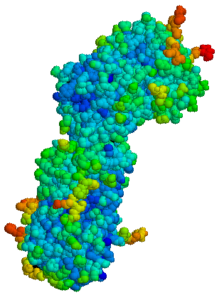Antithrombin III
| Antithrombin III | ||
|---|---|---|

|
||
| Dome model according to PDB 1E03 | ||
| Properties of human protein | ||
| Mass / length primary structure | 432 amino acids | |
| Identifier | ||
| Gene name | SERPINC1 | |
| External IDs | ||
| Drug information | ||
| ATC code | B01 AB02 | |
| Drug class | anticoagulant | |
| Inhibitor classification | ||
| MEROPS | I04.018 | |
| Occurrence | ||
| Parent taxon | Vertebrates | |
Antithrombin III (AT III) or antithrombin (AT) is an endogenous serpin synthesized in the liver and one of the most important natural inhibitors of blood coagulation.
effect
Antithrombin inhibits the serine proteases of plasmatic coagulation , proteolytically breaks down thrombin (factor IIa) and activates the synthesis of t-PA (tissue-type plasminogen activator) on the endothelial cells .
Antithrombin is the antagonist of thrombin. Its effectiveness is increased and accelerated by heparin (about 1000 times). A deficiency in antithrombin III can result in ineffectiveness of the heparin or a high heparin requirement. The AT III drops regularly after operations. It is therefore only suitable to a limited extent to demonstrate consumption coagulopathy .
Therapeutic use
AT III is slowly administered intravenously as a substitute for antithrombin deficiency. AT III is obtained by fractionation from human plasma protein obtained by means of blood donation (antithrombin from human plasma, hpAT) or isolated from the milk of genetically modified mammals (recombinant human antithrombin, rhAT).
Antithrombin from human plasma
The dosage of 1 IU / kg increases the AT III level by about 1–1.5% (trade names Anbinex , Kybernin , Atenativ ).
Recombinant human antithrombin
The milk from genetically modified goats from the farms of the US company GTC Biotherapeutics contains the recombinant human antithrombin, which bears the international non- proprietary name antithrombin alfa , in a concentration of up to 10 g per liter of milk. It was approved under the trade name ATryn in July 2006 for the European market and in February 2009 for the US market for the prevention of venous thromboembolism in surgical interventions on patients with hereditary antithrombin deficiency. The aim is also to expand the indication for patients in whom such a deficiency is not hereditary. Antithrombin alfa is the first drug made using genetically engineered animals. GTC selected goats for the trial because they reproduce faster than cattle and produce more protein than rabbits or mice, and claims that a genetically modified goat can produce the same amount of antithrombin per year as 90,000 donated blood. Genetic manipulation is carried out by microinjection of human antithrombin genes into the cell nucleus of a goat embryo . In parallel with the FDA's pharmaceutical regulatory board, the Center for Veterinary Medicine approved goat genetic engineering for drug production.
properties

Antithrombin is a glycoprotein whose protein component consists of 432 amino acids and is identical in antithrombin (hpAT) obtained from human plasma and the recombinantly produced antithrombin (rhAT). However, there are differences in glycosylation , i.e. H. Type and number of sugar chains attached to the protein. This results in a significantly different binding affinity for heparin, which is around four times stronger for rhAT in vitro than that of hpAT.
The inhibitory activity of rhAT and hpAT on thrombin (factor IIa) and factor Xa is about the same. It is based on the complex formation between antithrombin and the coagulation enzyme. The formation of the complexes takes place slowly, their breakdown takes place in the reticuloendothelial system . Heparin accelerates the formation of the antithrombin-clotting enzyme complex by about 1000 times. The antithrombin concentration in human plasma is normally 12.5–15 mg / dl. The antithrombin activity of 1 ml of normal human plasma is by definition 1 international unit (IU) per milliliter, which is also equated with 100%.
literature
- Soler E, Thépot D, Rival-Gervier S, Jolivet G, Houdebine LM: Preparation of recombinant proteins in milk to improve human and animal health . In: Reprod. Nutr. Dev. . 46, No. 5, 2006, pp. 579-88. doi : 10.1051 / rnd: 2006029 . PMID 17107647 .
- Sabine Panzer-Heinig: The antithrombin (III) - establishing reference values for childhood . Significance for the DIC 1992 versus 2007. August 18, 2009 (124 p., Fu-berlin.de - dissertation).
Web links
- Wolfgang Hübl: Information page on Antithrombin III
- P D'Eustachio: Common Pathway. In: reactome.org. EBI, August 24, 2004, accessed October 29, 2010 .
Individual evidence
- ↑ Occurrence at MEROPS
- ↑ Medicines from goats, cows and chickens . heise.de, June 23, 2008.
- ^ ATryn: Public assessment report and product information. European Medicines Agency , August 21, 2009.
- ^ Susan Heavey: US approves first drug from DNA-altered animals , Reuters . February 6, 2009. Retrieved February 7, 2009.
- ^ A b c Catherine Larkin: GTC Drug Is First From Genetically Engineered Animals , Bloomberg . February 6, 2009. Retrieved February 7, 2009.
- ^ Gary Stix: The Land of Milk and Money , Scientific American . January 15, 2009. Retrieved February 11, 2009.
- ↑ Andrew Pollack: FDA Approves Drug From Gene-Altered Goats. Retrieved February 7, 2009 .
- ↑ Phillip B. C Jones: European Regulators Curdle Plans for Goat Milk Human Antithrombin. April 2006, accessed February 7, 2009 .
- ↑ a b Scientific Discussion (PDF) European Medicines Agency, accessed April 8, 2010.